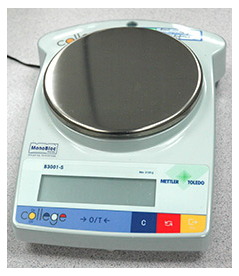Archival Notice
This is an archive page that is no longer being updated. It may contain outdated information and links may no longer function as originally intended.
Home | Glossary | Resources | Help | Contact Us | Course Map
Measurements
The term "weight" is commonly used synonymously for mass. Mass is the amount of matter in an object, and the International System of Units (SI) unit for mass is the kilogram (kg).02
A discussion and demonstration of the use of all types of balances in the laboratory, such as top-loaders and analytical balances, should be provided. If necessary, a review of basic math and standard measurements can be presented. Traceable standards, such as weight sets, are easily obtained for this purpose, or a laboratory may employ an outside entity to conduct the calibration. It should be noted that the outside entity must use traceable standards to conduct the calibration. A balance should be calibrated whenever it is moved.
Top-loading Balances
Top-loading balances are generally portable and ideal for easy weighing tasks. They have a larger weighing pan and may offer ranges such as 210g x 0.01g and 8100g x 1g, and are thus applicable for weighing chemicals to make stock reagents, etc. It is imperative that anyone using a balance know how to properly use features such as the external calibration and taring functions.
Analytical Balances
Analytical balances offer higher resolution and measuring quality, in ranges typically to 2.1g x 0.001mg and 510g x 0.1mg. Such tools are necessary in the preparation of some reagents in the forensic biology laboratory.
Additional Online Courses
- What Every First Responding Officer Should Know About DNA Evidence
- Collecting DNA Evidence at Property Crime Scenes
- DNA – A Prosecutor’s Practice Notebook
- Crime Scene and DNA Basics
- Laboratory Safety Programs
- DNA Amplification
- Population Genetics and Statistics
- Non-STR DNA Markers: SNPs, Y-STRs, LCN and mtDNA
- Firearms Examiner Training
- Forensic DNA Education for Law Enforcement Decisionmakers
- What Every Investigator and Evidence Technician Should Know About DNA Evidence
- Principles of Forensic DNA for Officers of the Court
- Law 101: Legal Guide for the Forensic Expert
- Laboratory Orientation and Testing of Body Fluids and Tissues
- DNA Extraction and Quantitation
- STR Data Analysis and Interpretation
- Communication Skills, Report Writing, and Courtroom Testimony
- Español for Law Enforcement
- Amplified DNA Product Separation for Forensic Analysts


